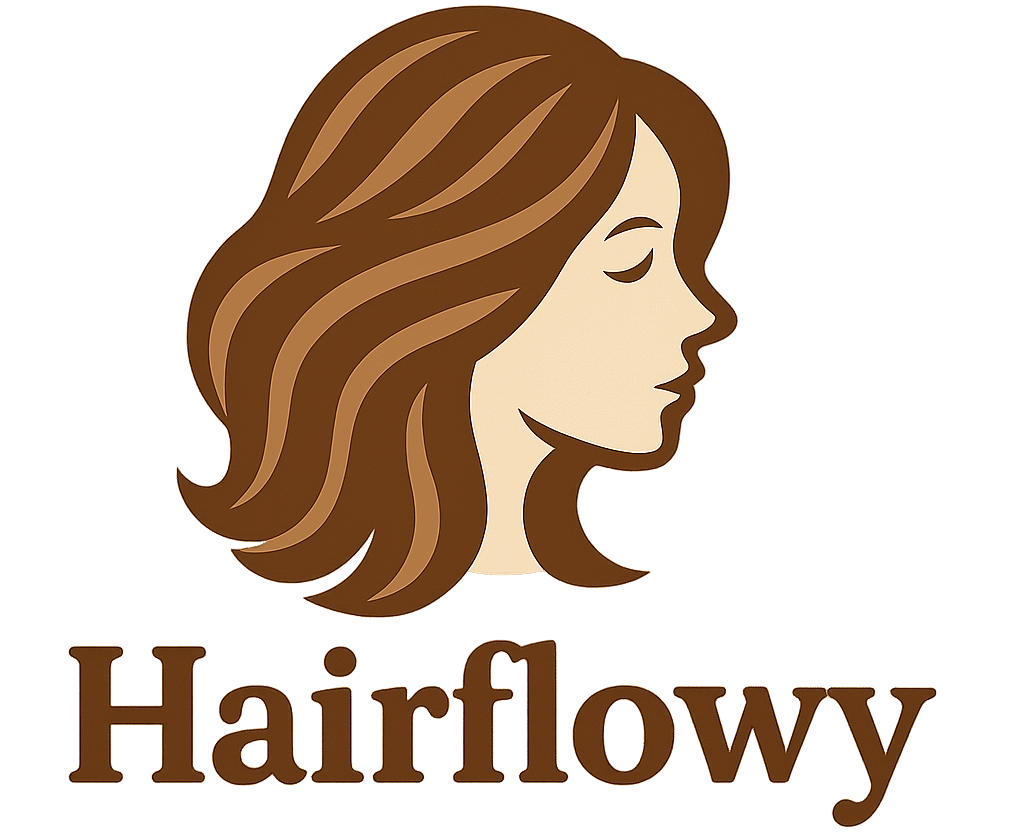Long thin hair doesn’t mean you’re limited to boring, lifeless styles. We’ve discovered countless ways to transform fine strands into stunning, voluminous looks that’ll make heads turn. Whether you’re dealing with naturally thin hair or experiencing thinning due to age or other factors, the right hairstyle can completely change your appearance and boost your confidence.
We understand the frustration of trying to create body and movement in hair that seems to fall flat no matter what you do. That’s why we’ve compiled the most effective styling techniques and cutting-edge haircut ideas specifically designed for long thin hair. From strategic layering to clever styling tricks, these approaches work with your hair’s natural texture rather than against it.
Ready to unlock your hair’s full potential? We’ll show you how to create the illusion of thickness, add incredible volume, and achieve styles that look effortlessly chic. Your thin hair is about to become your greatest asset.
Layered Cuts That Add Volume and Movement
Strategic layering transforms thin hair by creating the illusion of thickness while adding natural bounce and flow. Layers work by removing weight from exact sections, allowing hair to lift and move more freely.
Long Layers for Natural Body
Long layers start below the shoulders and gradually increase in length toward the ends. This cutting technique maintains your hair’s length while creating subtle movement that doesn’t overwhelm fine strands. We recommend requesting layers that begin at least 4-6 inches from your roots to preserve density at the crown.
Professional stylists cut long layers at varying angles to maximize volume. The technique involves removing minimal weight while creating enough variation in length to encourage natural lift. Long layers work exceptionally well for women who want to keep their hair’s length but need more body and swing.
Styling long layers requires minimal effort for maximum impact. Use a round brush while blow drying to enhance the natural movement, or scrunch with volumizing mousse for effortless waves. The gradual length variation creates dimension that catches light beautifully, making thin hair appear fuller and more ever-changing.
Face-Framing Layers for Definition
Face framing layers begin around the cheekbones and gradually blend into longer lengths. These strategic cuts create a flattering silhouette that draws attention to your best features while adding instant volume around your face. We suggest keeping these layers at least 2 inches longer than your shortest desired length to maintain versatility.
Customized face framing layers complement different face shapes and bone structures. Round faces benefit from longer layers that start below the chin, while angular faces look stunning with shorter layers that soften sharp jawlines. Your stylist should consider your natural part and cowlick patterns when determining the optimal starting point for these layers.
Maintenance for face framing layers involves regular trims every 6-8 weeks. These layers grow out more noticeably than other cutting techniques, so consistent upkeep ensures they continue to enhance your features. Use texturizing spray on damp hair before styling to enhance the layers’ definition and create separation between strands.
Choppy Layers for Texture
Choppy layers feature intentionally uneven lengths that create dramatic texture and movement. This edgier approach to layering removes more weight than traditional techniques, resulting in piece-y sections that add important volume to thin hair. The irregular cutting pattern prevents hair from lying flat against your head.
Modern choppy layers incorporate point cutting and razor techniques for enhanced texture. Stylists use these methods to create soft, feathered ends that blend seamlessly while maintaining the choppy effect. The variation in layer lengths ranges from 1-4 inches of difference, depending on your desired level of texture and your hair’s natural thickness.
Styling choppy layers emphasizes their textural qualities through strategic product application. Sea salt spray enhances the piece-y separation, while lightweight styling cream defines individual layers without weighing down fine strands. Finger styling rather than brush styling maintains the intentionally tousled appearance that makes choppy layers so effective for adding volume to thin hair.
Blunt Cuts That Create the Illusion of Thickness

Blunt cuts work wonders for thin hair by creating clean, polished lines that make each strand appear more robust. The straight, even ends give hair a fuller appearance while maintaining a sophisticated look that’s both timeless and versatile.
One-Length Bob Variations
One-length bobs transform thin hair by creating a solid wall of hair that appears thicker than it actually is. Styling these bobs with soft waves adds depth and dimension, creating movement that enhances the illusion of volume. Chin-length versions work particularly well since they concentrate hair density at the jawline, making the overall style appear fuller and more substantial.
Blunt Lob for Modern Appeal
Blunt long bobs offer contemporary styling that’s perfect for those who want length without sacrificing thickness. We love how this cut maintains clean edges while providing enough structure to make thin hair look dense and healthy. Customizing the lob with subtle asymmetrical elements or minimal layering can add texture without compromising the blunt effect that creates volume.
Straight-Across Ends for Density
Straight-across ends create the strongest visual impact for thin hair by forming a solid, uniform line that suggests thickness. This technique works across various lengths because it eliminates wispy, tapered ends that can make hair look sparse. Maintaining these clean edges requires regular trims every 6-8 weeks, but the payoff is hair that consistently appears fuller and more voluminous than its natural state.
Textured Styles That Enhance Natural Volume

Creating texture in long thin hair transforms flat strands into voluminous, ever-changing styles that command attention. These techniques work by manipulating the hair’s natural pattern to build body and movement from root to tip.
Beach Waves for Effortless Fullness
Beach waves deliver instant volume by creating loose, flowing curves that spread hair outward rather than letting it hang straight down. We achieve this coveted texture using a curling iron or wand to form gentle spirals, then gently finger through each curl while it’s still warm. This technique breaks up the uniformity that makes thin hair appear sparse.
Salt spray products enhance the beachy effect by adding grip and hold to fine strands. Apply the spray to damp hair before curling to maximize texture and longevity. The key lies in creating waves of varying sizes throughout your hair, which prevents the overly uniform look that can flatten thin hair against your head.
Tousled Curls for Added Dimension
Tousled curls create visual depth by forming multiple layers of texture that catch light differently at each angle. We recommend starting with smaller barrel curls, then immediately pulling them apart while the hair remains warm from styling. This pulling motion creates irregular, natural looking spirals that add substantial visual weight to thin strands.
Focus on curling away from your face in the front sections to open up your features and create lift around the crown. The tousled effect works particularly well when you alternate curl directions throughout your head, creating a multidimensional canvas that appears much fuller than straight hair.
Crimped Texture for Maximum Lift
Crimped texture delivers the most dramatic volume boost by creating hundreds of tiny ridges that literally lift hair away from your scalp. We use a crimping iron to press small sections of hair, concentrating on the roots and mid lengths where you need the most lift. This technique works exceptionally well for long thin hair because it creates maximum surface area.
Start crimping about two inches from your roots to avoid an overly retro appearance while still gaining important lift. The textured ridges interlock with surrounding hair strands, creating a fuller appearance that lasts throughout the day. Focus your crimping efforts on the crown and sides where thinning tends to be most noticeable.
Strategic Highlights That Add Depth and Dimension
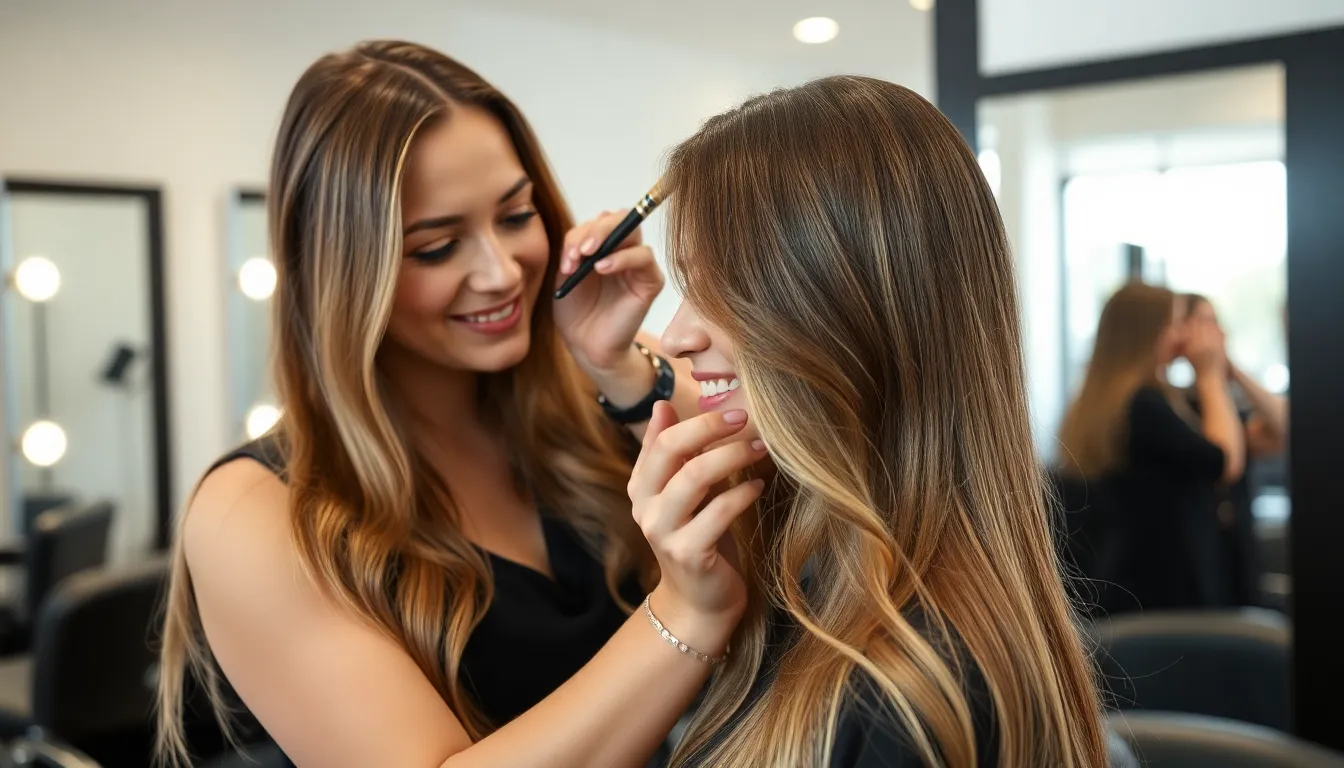
Coloring techniques can dramatically transform long thin hair by creating visual interest and the appearance of fuller strands. We’ll explore professional highlighting methods that add dimension while improving your hair’s natural beauty.
Balayage Techniques for Volume
Balayage creates stunning dimension through its signature sweeping motion application that mimics natural sun-kissed highlights. We recommend starting the highlights from mid-lengths to ends, which produces a layered visual effect that makes hair appear significantly thicker. Professional colorists use this freehand technique to paint color strategically, focusing on areas where light naturally hits your hair.
This method works exceptionally well for long thin hair because it breaks up solid color blocks that can make strands look flat. Placement becomes crucial – we suggest concentrating highlights on the top layers where they’ll catch light and create movement. The gradual transition from darker roots to lighter ends adds depth that tricks the eye into perceiving more volume than actually exists.
Lowlights for Shadow and Depth
Lowlights add essential shadow that creates the illusion of thicker, more dimensional hair through strategic darker shade placement. We typically use colors 1-2 shades darker than your base to create natural-looking depth without harsh contrasts. These darker tones should be woven throughout the hair, particularly in areas where shadows would naturally fall.
Shadow placement becomes especially important for thin hair because it creates the appearance of multiple hair layers stacked together. Professional colorists often combine lowlights with highlights to achieve maximum dimensional effect. The contrast between light and dark creates visual texture that makes individual strands appear more substantial and voluminous.
Face-Framing Highlights for Brightness
Face-framing highlights strategically brighten your complexion while drawing attention away from hair density concerns. We place these lighter pieces around the hairline, temples, and front sections to create a halo effect that illuminates your features. This technique works particularly well when highlights are 2-3 shades lighter than your natural color.
The key lies in placement precision – highlights should start closer to the roots around your face and gradually blend outward. This creates a brightening effect that makes your entire hairstyle appear more vibrant and full. Face-framing pieces also add movement when you turn your head, creating the illusion of bounce and volume that thin hair often lacks naturally.
Updos That Maximize Thin Hair Potential
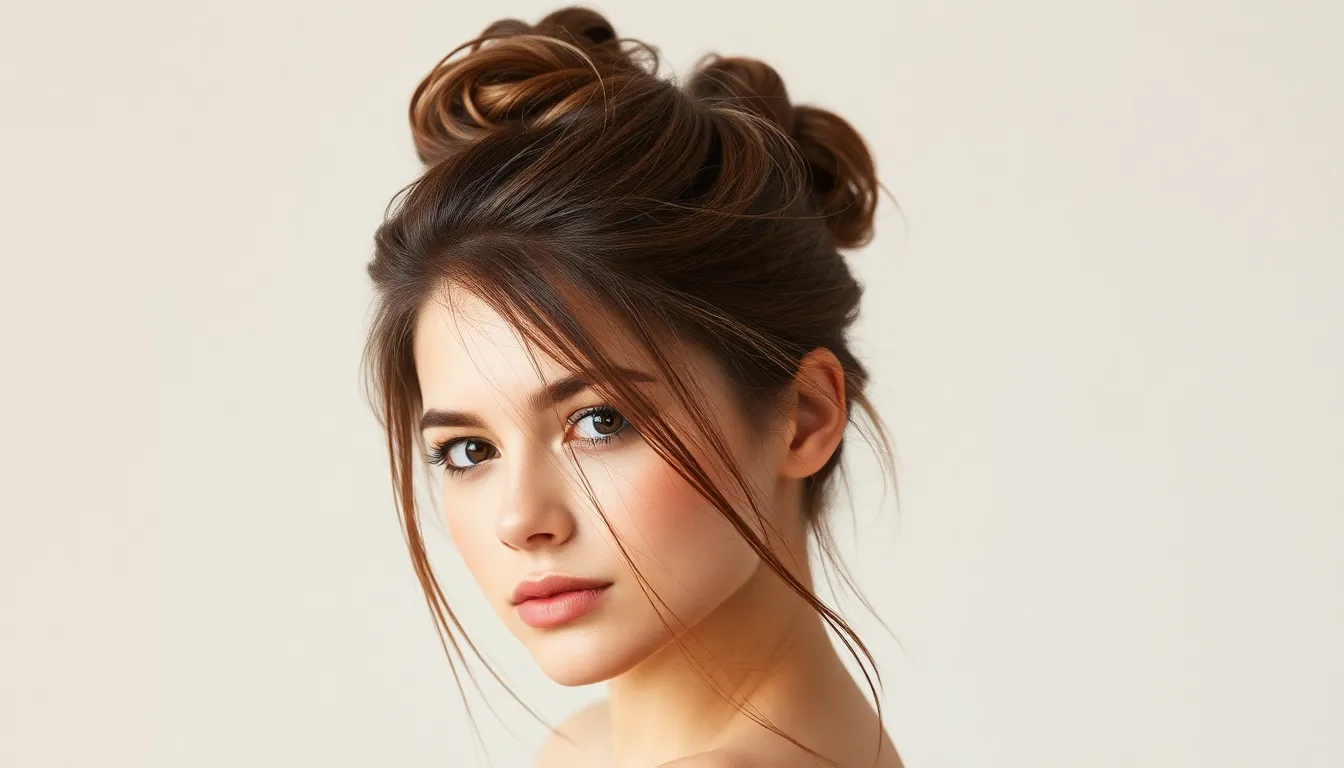
Updos transform long thin hair into sophisticated styles that create the illusion of fullness and density. These elevated hairstyles work by concentrating hair volume in strategic areas while adding height and texture.
Messy Buns with Teasing
Teasing creates essential volume at the roots before securing hair into a messy bun. We recommend using dry shampoo or light hairspray to lift strands and add grip, making thin hair appear thicker and more substantial. Starting with slightly dirty hair provides better texture and hold for this effortless style.
Messy crown buns work particularly well when you begin with a high ponytail and incorporate dry shampoo for added volume. The deliberately tousled finish conceals any sparse areas while creating a casual yet polished appearance that’s perfect for both everyday wear and special occasions.
Braided Styles for Texture
Side twists elevate classic braids by adding dimension and visual interest to thin hair. These twisted sections create texture while keeping strands securely in place, preventing the flat appearance that often plagues fine hair. The interweaving technique naturally adds bulk and movement to otherwise limp strands.
French braids provide sophisticated styling options that can be transformed into elegant buns or left loose for added texture. We find that braiding incorporates multiple hair sections together, creating the appearance of thicker, more substantial hair while adding intricate detail to updos.
Half-Up Styles for Height
Half up half down styles create instant height by securing the top portion of hair into a ponytail or bun. This technique frames the face beautifully while adding vertical volume that draws attention upward, making thin hair appear fuller and more ever-changing.
Half up knots offer casual charm through simple knotting techniques that add volume without complexity. Leaving a few face framing strands loose softens the overall look while the gathered top section creates the illusion of density and movement in thin hair.
Styling Products That Boost Volume and Hold
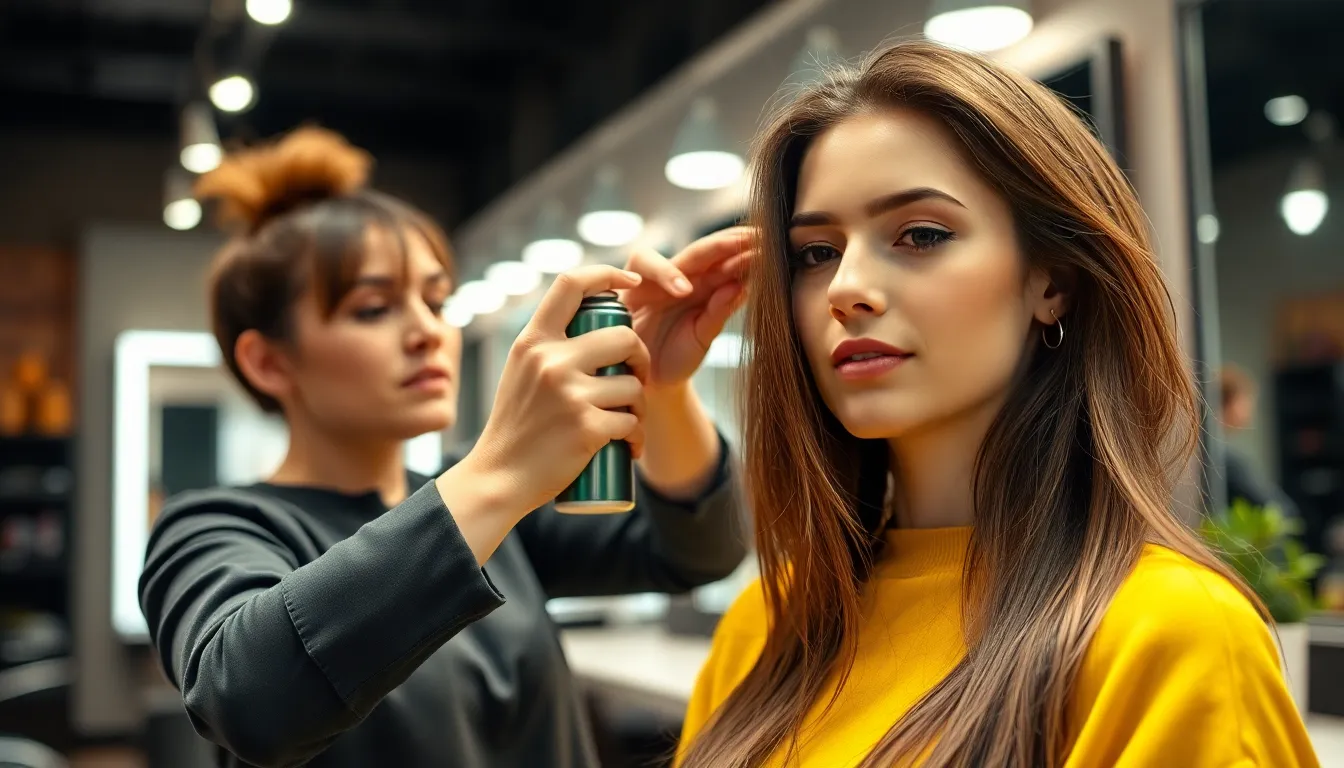
We’ve covered how to cut and style long thin hair, but the right products can make all the difference in achieving lasting volume and body.
Volumizing Mousses and Foams
Mousses transform long thin hair by creating lightweight lift without heaviness. We recommend applying these products to damp hair from roots to mid-lengths for maximum effect. Paul Mitchell Neuro Unscented Mousse delivers exceptional volume and definition while keeping strands feeling natural and bouncy.
Foams work similarly but provide different textures and hold levels. Redken Stay High Mousse stands out by offering maximum hold combined with textured volume that lasts up to 24 hours. These products create the foundation for voluminous styles by lifting hair at the scalp and adding body throughout each strand.
Application technique matters significantly with mousses and foams. We suggest dispensing product into palms, then scrunching upward from ends to roots while hair remains damp. This method ensures even distribution and prevents product buildup that can weigh down fine strands.
Texturizing Sprays and Powders
Texturizing sprays add essential grip and grit to smooth thin hair. John Paul Mitchell System Texturizing Spray creates definition and movement without adding weight or stiffness. We find these products particularly effective when applied to dry hair before styling with heated tools.
Dry shampoo powders serve dual purposes for long thin hair. They absorb excess oil while simultaneously adding texture and grip that makes styling easier. We recommend focusing application on roots and mid-lengths, then working the powder through with fingers for natural-looking volume.
Powders create more dramatic texture than liquid sprays. These products lift individual strands away from each other, creating space and visual density. We suggest using texturizing powders on second or third-day hair when natural oils provide additional grip for styling.
Root Lift Products for Maximum Impact
Root lift products target the most critical area for volume creation. Paul Mitchell Root Lift Spray delivers instant lift at the scalp while adding texture throughout the hair shaft. We apply these products to towel-dried hair, focusing on the crown and temples where thin hair tends to lay flattest.
Specialized shampoo and conditioner systems enhance root lift effects. Redken Volume Injection Shampoo & Conditioner features a bodifying complex that adds thickness while helping lift roots from the very first wash. These products create the ideal foundation for subsequent styling products.
Strategic application maximizes root lift product effectiveness. We recommend sectioning hair and applying product directly to the scalp, then lifting strands upward while blow drying. This technique creates lasting volume that supports the weight of long thin hair throughout the day.
Heat Styling Techniques for Fuller-Looking Hair
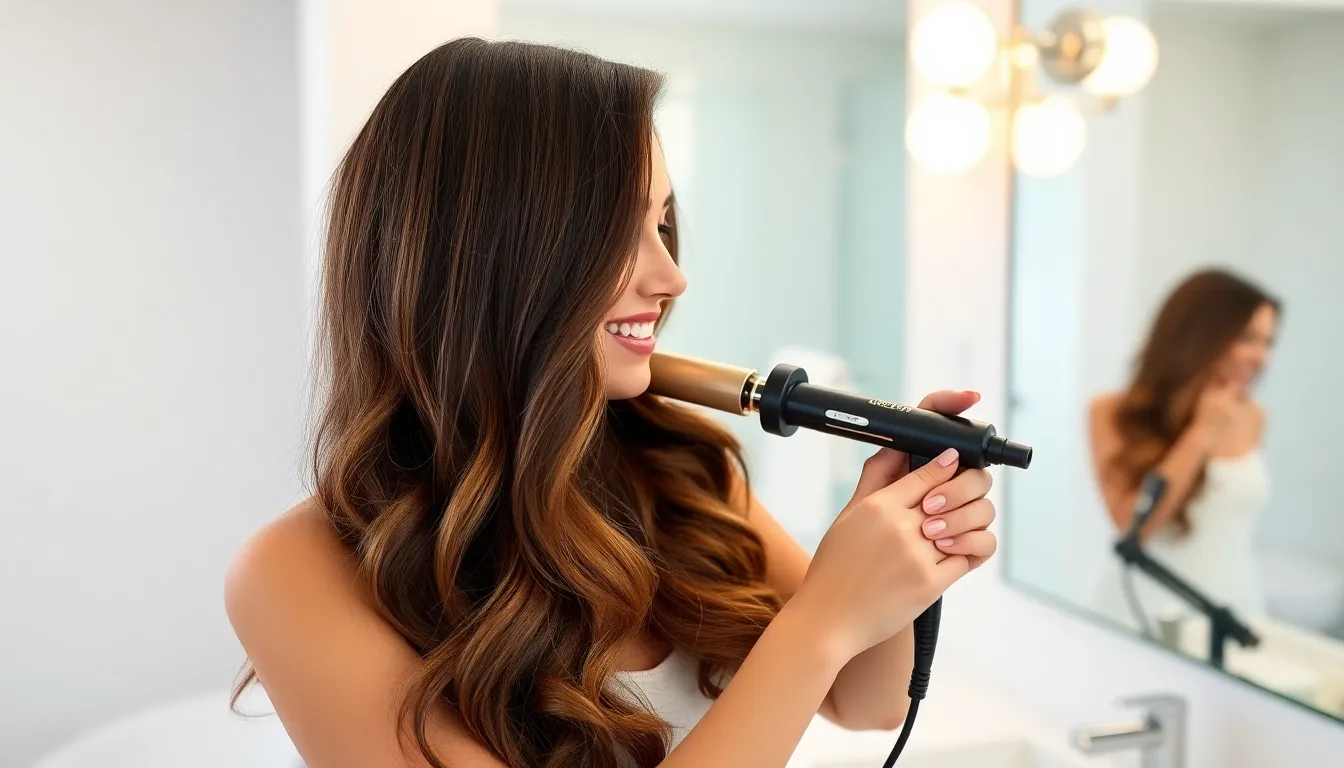
We’ll transform your thin strands into voluminous locks using strategic heat styling methods that create lasting lift and body.
Blow Drying Methods for Volume
Upside down blow drying maximizes volume at the roots by lifting hair away from the scalp while the follicles set in an elevated position. We recommend flipping your head completely upside down and directing the airflow from roots to mid-lengths using a round brush to create maximum lift.
Cold shot buttons enhance volume and set your style by sealing the hair cuticle in its lifted position. Apply the cold air blast for 10-15 seconds at the end of your blow drying session to lock in the volume you’ve created.
Sectional drying creates more targeted volume by allowing you to focus on exact areas that need extra lift. We suggest dividing your hair into 4-6 sections and blow drying each section individually with a paddle brush to ensure even volume distribution.
Curling Iron Techniques for Body
Loose curls add movement and body to thin hair by creating gentle waves that spread strands outward and prevent them from lying flat against your head. We recommend using a 1.5-2 inch barrel curling iron to achieve these effortless looking curls that won’t overwhelm fine hair.
Sectioned curls prevent tangling and distribute curls evenly throughout your hair for a more polished appearance. Divide your hair into horizontal sections starting from the bottom layer and work your way up, curling each piece away from your face for natural looking volume.
Alternating curl directions create natural looking texture that mimics how hair naturally falls and moves. We suggest curling some sections toward your face and others away to achieve a more organic, voluminous finish.
Flat Iron Tricks for Texture
Texturizing with flat irons adds subtle texture by creating gentle bends and movement in otherwise straight hair. We recommend lightly pressing damp hair with your flat iron while slowly pulling it through each section to create natural looking waves.
Root lifting with flat irons creates instant volume at the crown area where thin hair often falls flat. Place your flat iron close to the roots and gently lift upward while applying light pressure to create a subtle bump that adds height.
S-wave techniques enhance natural movement by creating flowing curves throughout your length. We suggest weaving your flat iron in an S-shaped pattern down each section of hair to achieve beachy waves that add important volume and texture to thin strands.
Maintenance Tips for Long Thin Hair Health

Maintaining healthy long thin hair requires exact care practices that protect delicate strands while preserving length and improving natural volume. We’ll explore essential maintenance routines that keep your fine hair looking its best.
Regular Trimming Schedule
Scheduling trims every 6-8 weeks prevents split ends from traveling up the hair shaft and weakening already delicate strands. We recommend targeting just the very ends to maintain length while eliminating damage that makes thin hair appear even more sparse.
Professional stylists suggest maintaining the shape of your chosen cut through regular appointments rather than waiting for obvious damage. Split ends create a frizzy appearance that reduces the visual density we’ve worked to achieve through layering and styling techniques.
Trimming also helps maintain the clean edges essential for blunt cuts that create thickness illusions. Regular maintenance ensures your hairstyle continues to appear fuller and more polished between salon visits.
Deep Conditioning Treatments
Deep conditioning treatments once weekly provide essential moisture and protein that thin hair desperately needs for strength and elasticity. We suggest focusing the conditioner on mid-lengths and ends while avoiding the scalp area to prevent weighing down roots.
Look for treatments containing keratin or hydrolyzed proteins that temporarily fill in microscopic gaps in damaged hair cuticles. These ingredients help create the appearance of thicker individual strands while improving overall hair health.
Apply treatments to damp hair and leave on for 10-15 minutes before rinsing thoroughly with cool water. This process seals the hair cuticle and locks in moisture without leaving heavy residue that could flatten your carefully created volume.
Gentle Brushing Techniques
Using wide tooth combs on damp hair minimizes breakage that can make thin hair appear even sparser over time. We recommend starting at the ends and working upward in small sections to gently detangle without pulling.
Detangling brushes with flexible bristles work better than traditional brushes for preventing hair loss during styling routines. Choose brushes specifically designed for fine hair to avoid unnecessary stress on delicate strands.
Avoid brushing dry hair aggressively as this creates static and can break individual hairs that you’ve worked to preserve through proper cutting and coloring techniques. Instead, use your fingers or a boar bristle brush to smooth styles between washes.
Common Mistakes to Avoid with Thin Hair

Many people with long thin hair unknowingly sabotage their volume goals through common styling errors. We’ll help you identify and correct these mistakes to maintain healthier, fuller-looking hair.
Over-Washing and Product Buildup
Over-washing strips our hair of its natural oils that provide essential thickness and protection. We recommend limiting washes to 2-3 times per week to preserve these natural oils that help thin hair appear fuller.
Product buildup creates another major obstacle for achieving volume in fine hair. Multiple products layer on the strands and weigh them down significantly. We suggest using only one or two lightweight products per styling session to maintain natural movement and bounce.
Dry shampoo becomes our best friend between washes, absorbing excess oil while adding beneficial texture. Strategic application at the roots creates lift without the damaging effects of frequent shampooing.
Heavy Products That Weigh Hair Down
Heavy creams and oils instantly flatten thin hair against the scalp, eliminating any natural volume. We always choose products specifically labeled “for thin hair” or “lightweight” to ensure they won’t compromise our styling efforts.
Silicone-based products create temporary shine but often result in long-term buildup that makes hair appear limp. Water-based formulas provide better results for thin hair because they don’t create coating that weighs strands down.
We avoid leave-in conditioners on the roots and instead focus application on mid-lengths and ends only. This targeted approach prevents the scalp area from becoming weighed down while still providing necessary moisture to prevent breakage.
Aggressive Brushing and Heat Damage
Aggressive brushing breaks delicate thin strands and reduces the overall density we’re working to maintain. We use wide-tooth combs or detangling brushes with flexible bristles that glide through hair without causing breakage.
Excessive heat styling damages the hair cuticle and makes thin hair appear even finer over time. We limit hot tool usage to 2-3 times per week maximum and always apply heat protectant spray before styling to prevent damage.
High heat settings above 300°F can permanently damage fine hair structure. We keep our styling tools on medium heat settings and take extra time to achieve the desired results rather than rushing with damaging high temperatures.
Brushing wet hair when it’s most vulnerable leads to important breakage in thin strands. We wait until hair is at least 80% dry before using any brush or comb to minimize damage and preserve every precious strand.
Conclusion
Long thin hair doesn’t have to be a styling limitation – it can become your greatest asset with the right approach. We’ve shown you that achieving fuller-looking hair is entirely possible through strategic cuts layers texturizing techniques and proper product selection.
Remember that consistency is key when caring for fine hair. Regular maintenance healthy styling habits and avoiding common mistakes will help you maintain that coveted volume and movement we’ve discussed throughout this guide.
Your hair journey is unique and what works for others might need adjustment for your exact needs. Experiment with different combinations of techniques and products to discover your perfect routine. With patience and the right knowledge you’ll transform your long thin hair into the voluminous stunning style you’ve always wanted.
Frequently Asked Questions
What are the best haircut techniques for adding volume to long thin hair?
Layered cuts are most effective for thin hair. Long layers starting below the shoulders maintain length while adding movement. Face-framing layers provide volume around the face and flatter different face shapes. Choppy layers create dramatic texture through uneven lengths, preventing hair from lying flat against the head.
How do blunt cuts help make thin hair appear thicker?
Blunt cuts create clean, polished lines that make each strand appear more robust. One-length bobs form a solid wall of hair that looks thicker, especially with soft waves. The straight-across ends create a uniform line that suggests thickness and density to the eye.
What styling techniques can create volume in long thin hair?
Beach waves spread hair outward with loose, flowing curves using salt spray for grip. Tousled curls form multiple texture layers for visual depth. Crimped texture creates tiny ridges that lift hair from the scalp, focusing on roots and mid-lengths for maximum volume effect.
Which coloring methods make thin hair look fuller?
Balayage creates a layered visual effect mimicking natural highlights. Strategic placement on top layers catches light and creates movement. Lowlights add shadow and depth using colors 1-2 shades darker than the base, while face-framing highlights brighten complexion and draw attention from density concerns.
What are the best styling products for volumizing thin hair?
Volumizing mousses like Paul Mitchell Neuro Unscented Mousse create lightweight lift. Texturizing sprays add grip and dimension while absorbing oil. Root lift products like Paul Mitchell Root Lift Spray target the scalp area for maximum volume at the roots.
How often should I trim long thin hair?
Trim every 6-8 weeks to prevent split ends and maintain your cut’s shape. Regular trims keep blunt edges clean and ensure hair consistently appears fuller. This maintenance is crucial for preserving the visual density that proper cutting techniques create.
What are common mistakes to avoid with long thin hair?
Avoid over-washing, which strips natural oils – limit to 2-3 times weekly. Don’t use too many styling products simultaneously, as this causes buildup. Avoid heavy creams and oils that flatten hair. Use gentle brushing techniques and limit heat styling to preserve hair health.
What updos work best for thin hair?
Messy buns work well by teasing for volume and using dry shampoo for grip. Braided styles like side twists and French braids add texture and prevent flatness. Half-up styles create height and beautifully frame the face while maximizing hair’s potential.
